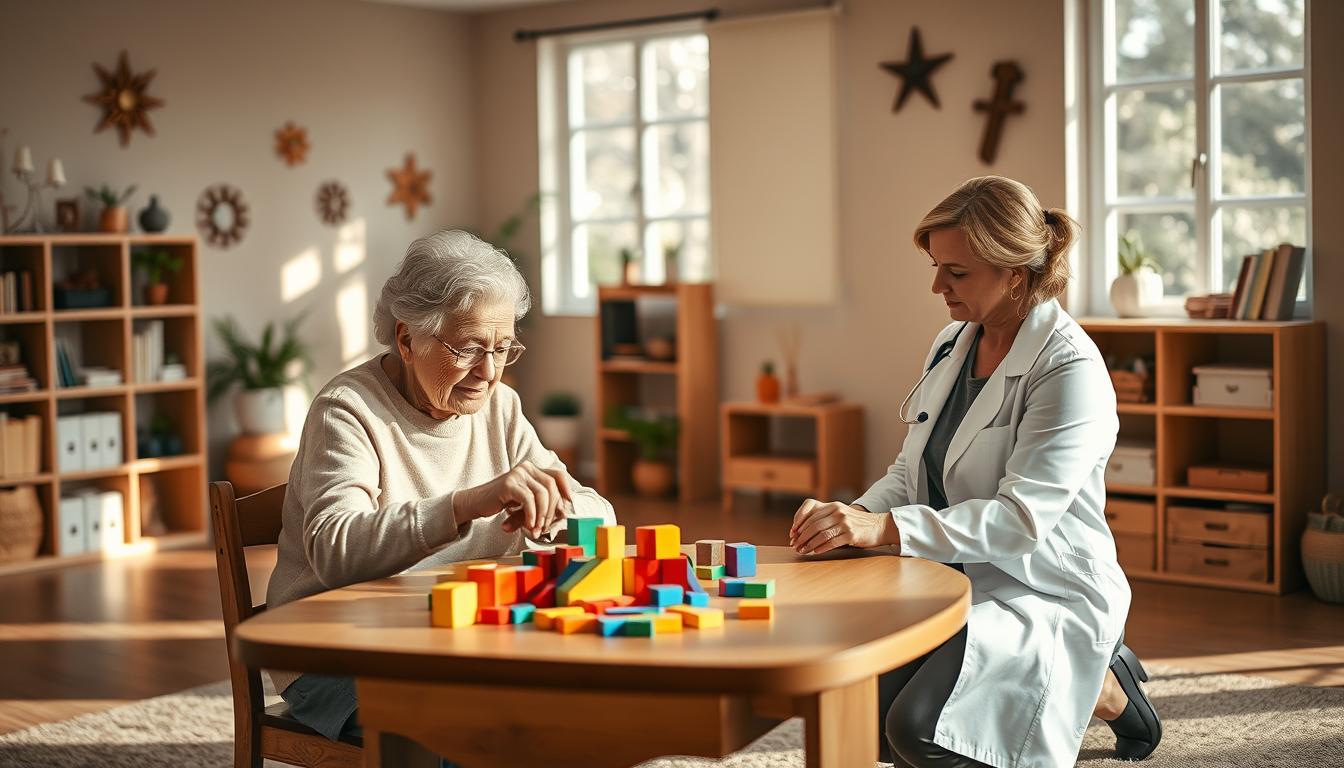- April 17, 2025
Welcome to Dementia World elderly home services



Did you know nearly 98% of people with dementia face neuropsychiatric symptoms (NPS)? These can include depression, psychosis, agitation, and apathy. They greatly affect the lives of both patients and their caregivers. As dementia worsens, caregivers often feel more stressed and depressed.
This shows how urgent effective dementia care is. Occupational therapy plays a key role here.
Occupational therapists (OTs) create custom plans to help people with dementia stay independent. They focus on daily tasks like bathing, dressing, and eating. OTs work to improve patients’ well-being and help caregivers manage Alzheimer’s care.
We will look into how occupational therapy helps in dementia care. We’ll see the DICE model, a top choice for treating NPS. This shows how OT improves life for those with dementia.
Occupational therapy is key in caring for dementia patients. It helps them do daily tasks on their own. Therapists work with each patient to find the best ways to help them.
This therapy boosts mental and emotional health, and physical well-being. Activities like memory games and solving puzzles keep the mind sharp. They help patients stay mentally active.
Therapists also teach ways to manage difficult behaviours. They make homes safer by removing dangers and adding safety features. This keeps patients safe and secure.

Activities that stimulate the senses, like art and music, lift patients’ moods. These activities make life better for those with dementia. They also help caregivers feel less stressed.
Working together, therapists and other healthcare teams create a supportive environment. This teamwork is vital for caring for dementia patients and their families.
Dementia is a group of brain disorders with different symptoms. Alzheimer’s disease is the most common, making up 60-80% of cases. It starts with memory loss and poor judgment, getting worse over time.
Vascular dementia is the second most common, making up 10-20% of cases. It affects focus and organisation, unlike Alzheimer’s which mainly affects memory. Other types, like Lewy body dementia and frontotemporal dementia, each make up about 4-5% of cases.
As people get older, the risk of dementia increases. By 65, the risk is nearly 1 in 14. This risk jumps to 1 in 6 by 80. Genes, like the APOE gene, also play a big role in Alzheimer’s risk.
Knowing about the different types of dementia helps us act faster. Caregivers can make better plans by understanding the specific dementia symptoms of each type.

| Type of Dementia | Prevalence (%) | Main Symptoms |
|---|---|---|
| Alzheimer’s Disease | 60-80 | Memory loss, judgment issues |
| Vascular Dementia | 10-20 | Cognitive decline, loss of focus, disorganisation |
| Lewy Body Dementia | 4-5 | Visual hallucinations, movement disorders |
| Frontotemporal Dementia | 4-5 | Changes in personality, behaviour |
Dementia care needs a wide approach, with non-drug methods key to improving life quality for patients and caregivers. About 80% of people with cognitive issues will show symptoms of dementia. Drugs often don’t work well over time, so we need to look at other ways.
Non-drug strategies cover many areas, like mental, behaviour, and environment needs. Studies show these methods are cheaper and safer than medicines. For example, talking therapies help patients cope with their condition. Support groups also help, creating networks for emotional and practical help.
Changing the environment is vital for making a safe and familiar space for people with dementia. Activities like music, dance, and animal therapy can bring joy and reduce stress. The Engage, Enable and Empower Project is a big step in improving dementia care, providing evidence-based help.
The table below shows how different non-drug methods work and where they can be used:
| Intervention Type | Effectiveness | Application |
|---|---|---|
| Psychological (e.g., CBT, support groups) | High for mood improvement | Individual and group settings |
| Behavioural (e.g., routine establishment) | Moderate for reducing BPSD | Daily living activities |
| Environmental (modifications) | High for creating secure spaces | Home and care facilities |
| Alternative therapies (e.g., music therapy) | Variable but promising | Group or individual sessions |

Occupational therapy is key in boosting daily living skills for people with dementia. It focuses on dementia care interventions tailored to each person. This helps them do things like grooming, cooking, and cleaning on their own.
Doing these tasks builds confidence and independence. These are vital for keeping dignity when memory loss happens.
Research shows that structured routines can cut caregiver stress by 30%. The right tools and knowledge help caregivers feel less stressed and anxious. This shows how important professional help is.

Simple tasks can also reduce frustration and agitation by 40%. Occupational therapists help people with dementia do daily tasks better. This makes them feel more accomplished and less stressed.
Using assistive devices is also key. For example, tub transfer benches can save up to 30 minutes per bath. This shows how occupational therapy can make a big difference.
Being part of the community is also important. 85% of therapists see better family relationships and communication. This is thanks to social participation strategies in occupational therapy.
In short, occupational therapy is vital for people with dementia and their caregivers. It focuses on structured support and practical help. This creates a better environment for patients to live in and thrive.
| Intervention Type | Benefit | Statistics |
|---|---|---|
| Structured Routines | Reduce caregiver burden | 30% reduction |
| Simplified Tasks | Decrease frustration and agitation | 40% decrease |
| Assistive Devices | Save caregiver time | 20-30 minutes per session |
| Social Participation Strategies | Enhance family communication | 85% observed improvement |
| Occupational Therapy Support | Improve daily living skills | 25% improvement |
The DICE approach is a new way to manage dementia, focusing on non-cognitive symptoms like agitation. It puts the patient at the centre, using detailed assessments to create custom care plans. The DICE stands for Describe, Investigate, Create, and Evaluate, showing how occupational therapists make care plans for each person.
This method tackles Behavioural and Psychological Symptoms of Dementia (BPSD), seen in over 90% of dementia patients. These symptoms can be hard on caregivers, making good management key. The DICE approach uses cognitive behavioural strategies to tackle these issues effectively.

The DICE approach aims to reduce distressing symptoms and improve life quality for dementia patients. It’s all about being flexible and sticking to cognitive behavioural strategies for success in managing dementia.
Occupational therapy helps people with dementia live better lives. It focuses on daily activities, making homes safe, and improving communication and thinking skills. These efforts make a big difference in their quality of life.
Improving daily tasks is key for dementia patients. They learn to do things on their own with special training. This helps them set goals like cooking, cleaning, and managing money.
These efforts boost independence and happiness. It helps them feel more like themselves.
Making homes safe is very important. Occupational therapists check homes and make changes like:
These changes make homes safer. They let people stay in their own places longer, needing less help from others.
Improving how people talk and think is also a big part of occupational therapy. Therapists use special methods to help with:
Through fun activities, people can talk more, move better, and think clearer. This makes them happier and helps them connect with others.
| Intervention Type | Benefits | Examples |
|---|---|---|
| Daily Living Activities | Independence, improved well-being | Meal preparation, personal hygiene |
| Home Modifications | Safety, reduced caregiver reliance | Grab bars, decluttering |
| Cognitive Therapies | Enhanced communication, social participation | Motor skills training, reasoning exercises |
Occupational therapy helps caregivers a lot. Up to 70% of them face big challenges like emotional, physical, and financial ones. It’s key to have support systems to help them care better for their loved ones.
One big plus of occupational therapy is it helps reduce stress in dementia caregivers. Studies show it can cut down dementia-related behaviours by up to 40%. This makes the environment calmer, helping caregivers do their tasks without stress.
Many caregivers, about 45%, feel really overwhelmed. Doing activities they enjoy can make life better for both them and their loved ones. For example, Skills2Care® has shown a 30-50% drop in caregiver burden by improving how they talk and interact.
Occupational therapy teaches caregivers important skills. It also helps people with dementia stay independent. By making changes and tailoring plans, daily activities can get better by 20-30%. Personalised care plans, like helping with dressing, can also boost cognitive skills for both.
Using tests like the MMSE helps occupational therapists know what’s needed. Signs like trouble with daily tasks or mood changes mean it’s time for therapy. It’s key to keep functionality and independence.
Occupational therapy is key in supporting people with dementia. It focuses on proven methods to help. A review of 15 trials with 2063 participants shows its success. The therapy involved eight sessions on average, aiming to improve life quality.
People with dementia showed big improvements in daily tasks, with a 0.61 score. This is a big win. They also saw a 0.22 score in doing more complex tasks, showing moderate success. Plus, there was a 0.32 score in reducing dementia symptoms, proving the therapy works.
Quality of life for both patients and their carers went up, with a 0.76 score. This improvement lasted, with a 1.07 score at follow-up. This shows how occupational therapy makes a big difference.
Carers also saw benefits, needing less time to help, with a -0.33 score. Emotional stress from dementia behaviours went down, with a -0.23 score. This is good news for those caring for others. Family carers’ quality of life improved, with a 0.99 score, showing the therapy’s wide benefits.
Yet, studies had a high risk of bias, mainly because of lack of blinding. The quality of evidence ranged from very low to moderate. It’s important to remember these points when looking at occupational therapy’s role in dementia care.
Occupational therapy is key in improving life for dementia patients. It offers tailored support and care strategies. With about 50 million people worldwide living with dementia, urgent care is needed.
These strategies help with daily tasks and meet emotional and social needs. They are vital for those with dementia and their caregivers. A supportive network is essential for managing the condition’s challenges.
The number of people with dementia is set to triple by 2050. This shows the need for a full care approach. Occupational therapy is critical in this effort.
We must advocate for occupational therapy in dementia care. It helps reduce dementia’s effects and keeps patients independent and dignified. By improving these interventions, we can greatly enhance the lives of dementia patients worldwide.
Occupational therapy is key in dementia care. It helps people stay independent and improve daily skills. Therapists tailor activities like grooming and cooking to meet each person’s needs. This boosts their quality of life.
There are many types of dementia, like Alzheimer’s and vascular dementia. Each has its own symptoms, like memory loss and changes in behaviour. Knowing these symptoms helps caregivers plan better care.
Non-drug methods are preferred because they avoid medication side effects. Activities that engage patients and care plans tailored to them can reduce symptoms. This approach is effective in managing dementia.
The DICE approach is a strategy for managing dementia symptoms. It stands for Describe, Investigate, Create, Evaluate. Occupational therapists use it to assess needs and set goals. This ensures care is tailored and improves wellbeing.
Occupational therapy helps with daily tasks through specific interventions. This includes practicing routines and making homes safer. It also improves communication and thinking skills through therapy.
Occupational therapy helps caregivers manage challenging behaviours and daily tasks. It reduces stress and boosts confidence. This makes caregiving easier and more fulfilling.
Studies and reviews show occupational therapy’s benefits. It improves daily living skills and reduces symptoms in dementia patients. It also enhances life quality for patients and caregivers, proving its vital role in care.